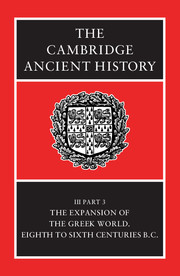Book contents
- Frontmatter
- Contents
- List of maps
- List of text-figures
- Preface
- 36a The Greeks in the Near East
- 36b The Greeks in Egypt
- 36c Cyprus
- 36d The Cypriot syllabary
- 37 The colonial expansion of Greece
- 38 The western Greeks
- 39a The eastern Greeks
- 39b Crete
- 39c Cretan Laws and Society
- 39d Euboea and the Islands
- 40 Illyris, Epirus and Macedonia
- 41 Central Greece and Thessaly
- 42 The Peloponnese
- 43 The growth of the Athenian state
- 44 The Tyranny of Pisistratus
- 45a Economic and social conditions in the Greek world
- 45b The material culture of Archaic Greece
- Chronological Table
- BIBLIOGRAPHY
- Index
- References
39b - Crete
Published online by Cambridge University Press: 28 March 2008
- Frontmatter
- Contents
- List of maps
- List of text-figures
- Preface
- 36a The Greeks in the Near East
- 36b The Greeks in Egypt
- 36c Cyprus
- 36d The Cypriot syllabary
- 37 The colonial expansion of Greece
- 38 The western Greeks
- 39a The eastern Greeks
- 39b Crete
- 39c Cretan Laws and Society
- 39d Euboea and the Islands
- 40 Illyris, Epirus and Macedonia
- 41 Central Greece and Thessaly
- 42 The Peloponnese
- 43 The growth of the Athenian state
- 44 The Tyranny of Pisistratus
- 45a Economic and social conditions in the Greek world
- 45b The material culture of Archaic Greece
- Chronological Table
- BIBLIOGRAPHY
- Index
- References
Summary
The burgeoning prosperity of Crete in the Geometric period continues through the seventh century. The record is clear from the archaeological evidence of its many sites and this is a record which must be respected, for there is no other. The reticence of ancient authors about this period in Cretan history stands in marked contrast with their readiness to discuss Crete's laws and society: the latter is due to Crete's distinctive practices and their alleged similarities to those of Sparta, the former to the island's comparative unimportance economically and militarily in the Classical period. Crete's society and laws will be discussed in the following section: here we deal with her archaeology and the history of her material culture.
Crete of the hundred – or ninety – cities (Il. II. 649; Od. XIX. 174) was not the only part of Greece to enjoy a wholly distinctive orientalizing culture, nourished by continued contact with Cyprus, Egypt and the Near East. But in Crete the culture is idiosyncratic and it is mainly inbred. It is expressed in a great diversity of products – painted and relief vases, jewellery, sculpture, bronzework and especially armour – and from city to city there seems to have been no less diversity in ways of life, and death.
In the later Geometric period (the second half of the eighth century and a little later) and the rest of the seventh century close on one hundred sites are known in the island. The Late Geometric is the period of maximum activity, it seems, though the fact that nearly two fifths of the sites seem not to survive far into the seventh century could well be illusory since the later material is not always easily identified or it has yet to be found.
- Type
- Chapter
- Information
- The Cambridge Ancient History , pp. 222 - 233Publisher: Cambridge University PressPrint publication year: 1982
References
- 2
- Cited by

